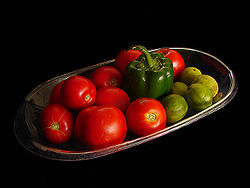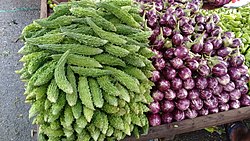Vegetable


Vegetable is a culinary term. Its definition has no scientific value and is somewhat arbitrary and subjective. All parts of herbaceous plants eaten as food by humans, whole or in part, are generally considered vegetables. Mushrooms, though belonging to the biological kingdom fungi, are also commonly considered vegetables. Though the exceptions are many, in general, vegetables are thought of as being savory, and not sweet. Nuts, grains, herbs, and spices are normally not considered vegetables.
Fruit, Vegetable
Since “vegetable” is not a botanical term, there is no contradiction in referring to a plant part as a fruit while also being considered a vegetable (see diagram below). Given this general rule of thumb, vegetables can include leaves (lettuce), stems (asparagus), roots (carrots), flowers (broccoli), bulbs (garlic), seeds (peas and beans) and botanical fruits such as cucumbers, squash, pumpkins, and capsicums. Botanically, fruits are reproductive organs (ripened ovaries containing one or many seeds), while vegetables are vegetative organs which sustain the plant.
The merits of the ongoing question, "is it a fruit, or is it a vegetable?", have even found its way before the bench of the United States Supreme Court which ruled unanimously in Nix v. Hedden, 1883, that a tomato is a vegetable for the purposes of 1883 Tariff Act even though botanically, a tomato is a fruit.
Commercial production of vegetables is a branch of horticulture called olericulture.
Etymology
Vegetable is also used as a literary term for any plant: vegetable matter, vegetable kingdom.[1] It comes from Latin vegetabilis (animated) and from vegetare (enliven), which is derived from vegetus (active), in reference to the process of a plant growing. This in turn derives from the Proto-Indo-European base *weg- or *wog-, which is also the source of the English wake, meaning "not sleep". The word vegetable was first recorded in print in English in the 14th century. The meaning of "plant grown for food" was not established until the 18th century. [2]
Vegetables in the diet
Vegetables are eaten in a variety of ways as part of main meals and as snacks. The nutrient content of different types varies considerably. With the exception of pulses, vegetables provide little protein and fat.[3][4] Vegetables contain water soluble vitamins like vitamin B and vitamin C, fat-soluble vitamins including vitamin A and vitamin D, and also contain carbohydrates and minerals.
Color in vegetables

The green color of leafy vegetables is due to the presence of the green pigment chlorophyll. Chlorophyll is affected by pH and changes to olive green in acid conditions, and bright green in alkaline conditions. Some of the acids are released in steam during cooking, particularly if cooked without a cover.
The yellow/orange colors of fruits and vegetables are due to the presence of carotenoids, which are also affected by normal cooking processes or changes in pH.
The red/blue coloring of some fruits and vegetables (e.g. blackberries and red cabbage) are due to anthocyanins, which are sensitive to changes in pH. When pH is neutral, the pigments are purple, when acidic, red, and when alkaline, blue. These pigments are very water soluble.
Storage of vegetables
Potatoes and other root vegetables should be stored in a dark, cool, and dry place to prevent mold, greening and sprouting.
During storage leafy vegetables lose moisture and vitamin C degrades rapidly. They should be stored for as short a time as possible in a cool place in a container, such as a plastic bag.
Many root vegetables can be stored through winter in a root cellar. Care should be taken in understanding the properties and vulnerabilities of the particular roots to be stored. Many can last through to early spring and be nearly as nutritious as when fresh.
See also
Notes
- ^ Swedenborg, Emanuel. (2003) Swedenborg Concordance 1888. Kessinger Publishing. p. 502. ISBN 0-7661-3728-7.
- ^ Ayto, John (1993). Dictionary of Word Origins. New York: Arcade Publishing. ISBN 1-55970-214-1.
- ^ Woodruff, Sandra. (1995) Secrets of Fat-Free Cooking. Avery. p. 85. ISBN 0-89529-668-3.
- ^ Whitaker, Julian. (2001) Reversing Diabetes. Warner Books. pp. 269-71. ISBN 0-446-67658-6.
